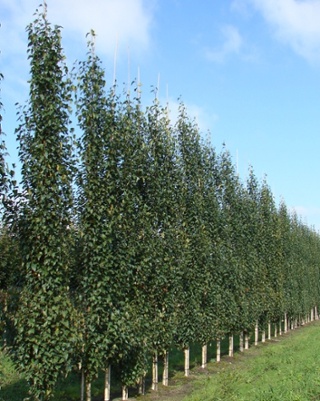Betula pendula Fastigiata
€150.00 – €425.00Price range: €150.00 through €425.00
Frequently Bought Together

+

Total: €23.00
Description
Quick Facts
- Common Name: Fastigiate Silver Birch, Upright Silver Birch, Columnar Birch
- Botanical Name: Betula pendula ‘Fastigiata’
- Plant Type: Deciduous tree
- Mature Height: 12-15m
- Mature Spread: 3-4m
- Flowering Period: March to April
- Flower Colour: Yellow-brown male catkins, green female catkins
- Foliage: Triangular to diamond-shaped leaves, bright green turning golden-yellow in autumn
- Hardiness: RHS H7 (very hardy)
- Soil Requirements: Moist, well-drained, tolerates most soil types including poor soils
- Aspect: Full sun to partial shade
- Maintenance: Low
Description
Experience the elegant beauty of Betula pendula ‘Fastigiata’, the stunning Fastigiate Silver Birch that brings exceptional architectural presence, space-efficient vertical form, and classic birch character to your garden with its naturally narrow habit and brilliant white bark. This outstanding ornamental birch offers remarkable qualities—a naturally narrow, strongly upright columnar form that remains exceptionally compact, reaching only 3-4m wide even at maturity whilst growing 12-15m tall, making this perfect for restricted spaces, avenues, and contemporary plantings where traditional birches would be far too wide, brilliant white bark that develops distinctive black diamond-shaped markings creating stunning year-round visual impact and winter interest, beautiful bright green triangular leaves that create fresh summer foliage before transforming into warm golden-yellow autumn colour, and graceful yellow-brown catkins in early spring that herald the arrival of the new season, making this one of the finest and most versatile columnar trees for creating dramatic vertical accent, contemporary elegance, and enduring beauty in Irish gardens and landscapes.
Throughout spring and summer, this captivating tree displays its characteristic triangular to diamond-shaped leaves measuring 4-7cm long with doubly serrated edges and a pointed tip in bright to mid-green, creating attractive, airy foliage that trembles and dances in the slightest breeze. The naturally narrow, strongly upright branching creates a distinctive columnar silhouette that remains remarkably compact and formal without any pruning—a true pillar of green throughout summer. In early spring before the leaves emerge, the tree becomes adorned with pendulous yellow-brown male catkins measuring 5-10cm long that hang gracefully from the branches, whilst shorter green female catkins appear on the same tree. In autumn, the foliage transforms into beautiful shades of golden-yellow and butter-yellow, creating warm colour before falling to reveal the tree’s most spectacular feature—the brilliant white bark. The bark starts bronze-brown on young trees, gradually developing the characteristic gleaming white colour with distinctive black diamond-shaped fissures and markings that create stunning contrast and year-round architectural impact.
This remarkable cultivar is a selected form of our native Silver Birch (Betula pendula), bred for its exceptional narrow, upright form. Unlike the common Silver Birch with its spreading, weeping branches, ‘Fastigiata’ maintains a tight, columnar habit perfect for smaller spaces. Exceptionally hardy and adaptable, this birch thrives in Irish conditions, tolerating exposure, urban pollution, poor soils, acidic to slightly alkaline conditions, and even coastal situations. Fast-growing and establishing quickly, providing impact within a few years. The narrow columnar form makes this ideal for situations where the grace and beauty of a birch is desired but space is limited—bringing birch elegance to medium-sized gardens, avenues, and urban settings.
Create stunning compositions by planting as magnificent avenue trees where the uniform columnar habit creates dramatic formal impact—perfect for driveways, pathways, or contemporary street plantings. Exceptional as vertical accent specimens in gardens, urban landscapes, or modern designs where height and architectural presence are desired without excessive width. Works beautifully in groups of three or five for enhanced impact, creating elegant groves with multiple white trunks. Magnificent flanking entrances or framing buildings. The narrow form makes this ideal for urban gardens, courtyards, or restricted spaces. Plant where the brilliant white bark can be appreciated year-round, particularly stunning when backlit by low winter sun or illuminated at night.
Caragh Garden Notebook
Planting: Space trees 4-5m apart for avenue plantings to allow the narrow crowns to just touch at maturity, or allow 5-6m for specimen placement. Plant bare-root trees from November to March, or container-grown specimens year-round (autumn or early spring is ideal). Dig holes twice the width of the root ball and incorporate organic matter. Plant at the same depth as the nursery soil mark. Stake for the first 2-3 years. Water thoroughly and mulch around the base, keeping mulch away from the trunk to showcase the beautiful bark. Choose positions where the white bark can be appreciated.
Soil Preparation: Thrives in moist, well-drained soil with pH 5.0-7.5. Tolerates a remarkably wide range of soil types including clay, loam, sand, and moderately acidic to slightly alkaline conditions. Adapts well to poor, infertile soils better than most trees—one of the best trees for challenging sites. Dislikes waterlogged or very chalky soils. Tolerates urban pollution, exposure, and coastal conditions. Best growth occurs in full sun to partial shade with consistent moisture, though very adaptable once established. Prefers cooler conditions.
Container Growing: Not suitable for long-term container growing due to size, vigorous growth, and extensive root system. Young specimens can be grown temporarily in very large containers (minimum 70cm diameter) using soil-based compost for 2-3 years, but should be planted out for best long-term health, characteristic columnar form development, and to allow the spectacular white bark to develop fully.
Seasonal Care: Requires minimal to no pruning—the naturally narrow, upright columnar form develops perfectly without intervention. Remove only dead, damaged, or diseased branches in late summer to early autumn (July-September)—never prune in spring when sap is rising heavily as birches bleed profusely. Never top or heavily prune as this destroys the characteristic columnar form. Apply slow-release balanced fertiliser in early spring if desired, though birches are generally undemanding. Mulch annually with organic matter. Water during dry spells in the first 3-5 years until established. Generally pest and disease resistant, though can be affected by birch dieback in some areas.
Propagation: Cannot be propagated from seed as this is a selected cultivar that will not come true from seed and will revert to the spreading form of common Silver Birch. Professional propagation is by grafting onto Betula pendula rootstock in winter or early spring. Budding in summer is also used commercially. Home gardeners should purchase nursery-grown grafted specimens for guaranteed quality, reliable narrow columnar form, and characteristic growth habit.
This elegant beauty is absolutely stunning—that naturally narrow, upright columnar form brings all the grace and beauty of a silver birch to spaces where traditional birches would never fit! The brilliant white bark with black diamond markings is gorgeous year-round, and that golden-yellow autumn colour is lovely. Graceful catkins in spring, fast-growing, exceptionally hardy, tolerates poor soils and challenging conditions brilliantly. Birch elegance in a space-efficient package—pure contemporary beauty!
Related products
-
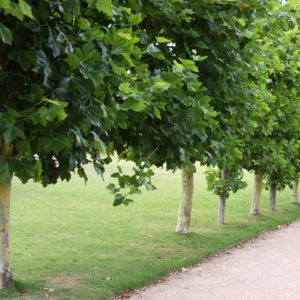
Platanus acerifolia / London Plane Tree
€320.00 – €700.00Price range: €320.00 through €700.00 Select options This product has multiple variants. The options may be chosen on the product page -
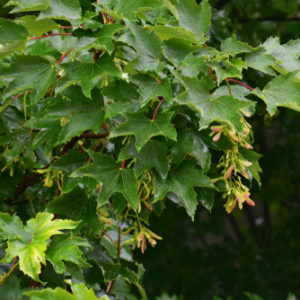
Acer platanoides
€250.00 – €500.00Price range: €250.00 through €500.00 Select options This product has multiple variants. The options may be chosen on the product page -
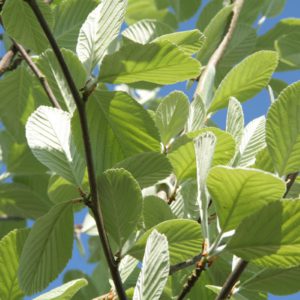
Sorbus aria Lutescens / Whitebeam
€520.00 Select options This product has multiple variants. The options may be chosen on the product page -
Sale!
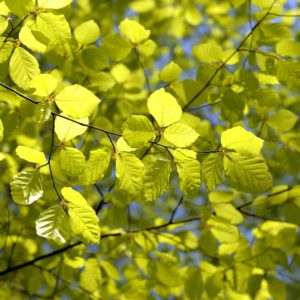
Fagus sylvatica / Beech Trees
€150.00 – €600.00Price range: €150.00 through €600.00 Select options This product has multiple variants. The options may be chosen on the product page

